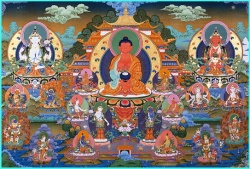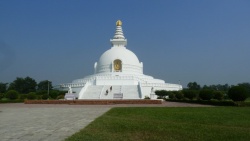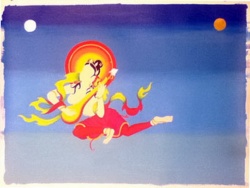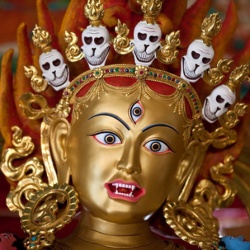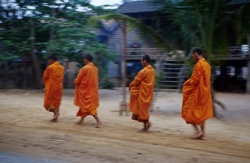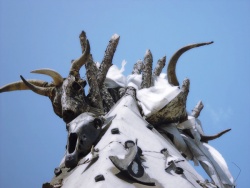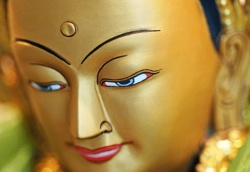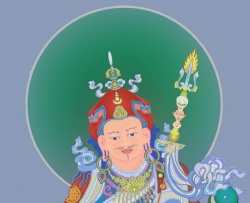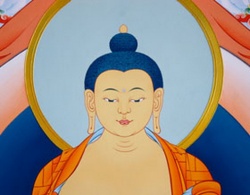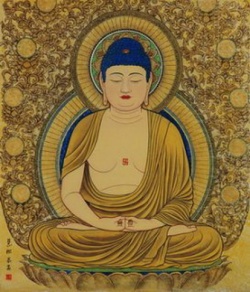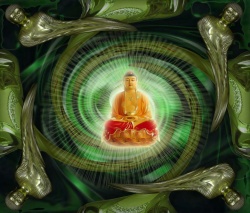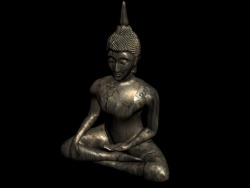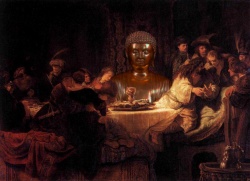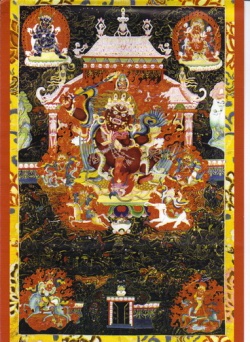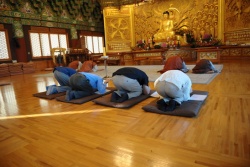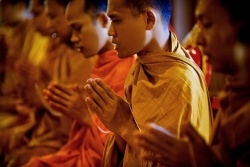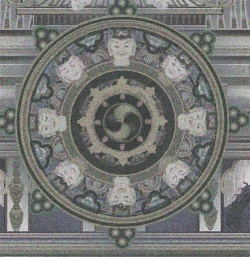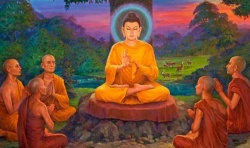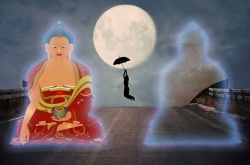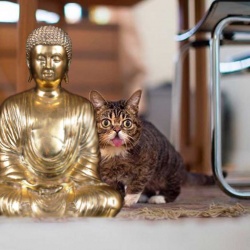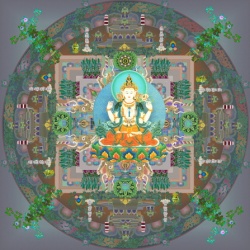Atman is the Witness of the Three States
There are three states viz., Jagrat (waking), Svapna (dreaming) and Sushupti (deep sleep or dreamless sleep). Avastha means a state.
The Vedantic school of thought attaches very great importance to the examination and study of the three Avasthas or conditions of life called waking, dream and dreamless sleep.
It insists that these three states should be investigated thoroughly before one starts the meditation on the Atman which is hidden in all these names and forms, which is the witnessing consciousness of all the three states.
You will find in Mandukyopanishad: The first quarter (foot) is Vaisvanara whose sphere is the state of waking, who is cognisant of the objective, who has seven members and seventeen mouths and whose fruition consists of the gross.
The following are the seven members (Sapthanga):
The effulgent region (heaven) is his head, the sun is his eye, the wind blowing in all directions is his breath, fire is his mouth, the all-embracing Akasa is his trunk or middle, ocean is his bladder or urinary reservoir, and the earth is his feet.
The nineteen mouths (Ekonavimsathimukha) are the five organs of knowledge, the five organs of actions, five Pranas, mind, intellect, Chitta and Ahamkara.
The second quarter is the Taijasa whose region is dream, who is cognisant only of the subjective, who has seven members and nineteen mouths and whose fruition consists of the subtle.
The experiencer of the state of dream is called Taijasa, because, it being entirely of the essence of light,
becomes the cogniser of the mind (consisting entirely of Vasanas and projecting itself into various shapes) irrespective of the objective.
That is the state of deep sleep wherein the sleeper does not imagine anything and does not see any dream.
The third quarter therefore is the Prajna, whose sphere is deep sleep, in whom all melts into one, who is a mass of all sentience, who is all bliss, whose function is of bliss and who is the way of sentience to the object.
Jagrat is that state during which the Jivatma enjoys the gross objects of senses such as sound, etc., through the fourteen organs such as the mind etc., having the sun and the rest as their presiding deities.
Svapna is that state during which the Jivatma experiences through the fourteen organs associated with the Vasanas of the waking condition, sound and other objects, which are of the form of the Vasanas created for the time being, even in the absence of gross sound and others.
The Jivatma experiences Sushupti when it does not experience sound and other objects of senses from the cessation of the functions of the fourteen organs, there being no special enjoying consciousness on account of the absence of these organs.
Virat under the orders of Isvara having entered this microcosmic body, and having Buddhi as his vehicle, reaches the state of Visva.
Then he goes by the general names of Vijnanatma, Chidabhasa, Visva, Vyavaharika, the one presiding over the waking gross body and the one generated by Karma.
Sutratma (Hiranyagarbha) under the orders of Isvara having entered the microcosmic subtle body, and having Manas (mind) as his vehicle reaches the Taijasa state.
Then He goes by the name of Taijasa, Pratibhasika and Svapna Kalpita (the one bred out of dream).
Then under the orders of Isvara, he who is coupled with Avyakta, the vehicle of Maya, having entered the microcosmic Karana body, reaches the state of Prajna.
He goes then by the names of Prajna, Avicchinna, Aparamatrika and Sushupti-Abhimani (the presider over Sushupti).
In Jagrat state the seat of Jiva is the eye. The Vak is Vaikari.
The enjoyment is of a gross character. The Jiva enjoys the gross sensual objects.
The Sakti that operates is the Kriya Sakti.
The prevailing Guna is Rajoguna.
The Abhimani or he who identifies with the state is known as Visva.
In Svapna state the seat of the Jiva is neck (Hita Nadi).
The Vak is Madhyama. The Jiva experiences subtle enjoyment through Vasanas.
The Sakti that operates is the Jnana Sakti.
The prevailing Guna is Sattvaguna. The Abhimani or he who identifies with the state is called Taijasa.
The seat of the Jiva during deep sleep is the heart.
The Jiva enjoys the bliss of the Self. The Sakti is Dravya Sakti.
The prevailing Guna is Tamoguna.
The Abhimani or he who identifies with this state is Prajna. The tabular form that is given below will help you to remember the different points quite easily.
Jagrat Avastha, Svapna Avastha, Sushupti Avastha
Seat of Jiva is the eye, Seat is neck, Seat is heart
Vaikhari (Vak), Madhyama, Pasyanti
Gross enjoyment, Subtle (Vasana-maya) enjoyment, Ananda (Bhoga)
Kriya Sakti, Jnana Sakti, Dravya Sakti
Rajo Guna, Sattva Guna, Tamo Guna
Abhimani is Visva, Abhimani is Taijasa, Abhimani is Prajna
Fill a pot with the water of the sea, tie a rope to the neck of the pot and immerse the pot in the sea.
Although the water of the pot is one with the water of the sea, it appears to be separate on account of the limiting adjunct, pot.
When you draw out the pot again by the rope, the water of the pot gets differentiated. But the ether which supports the pot which contains water and the sea is always of one homogeneous essence during the three periods of time.
Even so, the pot of subtle body or Linga Sarira of the Jiva that is filled with the sea-water of Ajnana and that is tied by the rope of Adrishta (the Samskara of good and evil deeds) gets involved during deep sleep in Samashti Ajnana which is the Upadhi of Isvara, viz., Maya.
Although Vyashti Ajnana or the individual ignorance, the Upadhi of Jiva has become now one with the Samashti Ajnana, the sum total of all individual ignorances,
it appears to be separate on account of the Upadhi of Linga Sarira.
When the Antaryami or the Inner Ruler draws the rope of Adrishta, it gets differentiated.
Then the Jiva comes back to the waking state. But the Chidakasha or the Atman or the silent Sakshi of the three states which is the support for the pot of subtle body,
which is associated with the water of individual ignorance and the sea of collective Ajnana is always of one homogeneous essence during the three periods of time.
A witness is one who observes another person or his states or his actions in those states, without himself being affected thereby. A spectator in a football or cricket match is a witness.
He is not in any way affected by the success or failure in the match. He is a mere witness only who really enjoys the play.
Ramdas was doing Japa in a temple. Mr. Joshi and Mr. Banerji sat in front of Ramdas and did Japa for an hour.
Then Mr. Joshi asked Mr. Banerji to return the money which he took as a loan two years ago. They were talking mildly for an hour.
Then Mr. Joshi spoke to Banerji harsh words and asked him to return the money immediately. Banerji refused to give back the money.
Both began to fight. Then Joshi went to a police officer and reported: Mr. Banerji took a loan from me two years ago. I asked him to return the money.
He abused me and also beat me. The police officer asked Mr. Joshi: Have you got any witness? Mr. Joshi replied: Yes. I have a witness.
[Ramdas who was doing Japa in the temple is the witness. Just as the witness sees two fighting persons in an unconcerned manner, so also the Atman witnesses the three states; Jagrat, Svapna and Sushupti without being affected in any way.
In the above illustration, the state of silence kept up by Joshi and Banerji during Japa corresponds to the deep sleep state.
There are no Vyapakatraya in this state.
Joshi and Banerji are Avasthavasis, Ramdas is the witness.
The state in which they were talking mildly corresponds to the dreaming state. The state in which they were fighting corresponds to the waking state.
Illustrations are always Ekadesik. Do not stretch them too much.
They explain one point only. The Vyavahara or activities are of three kinds, viz., physical, verbal and mental.
Ramdas was witnessing the activities of Joshi and Banerji.
He was not in any way affected by their activities. A Sakshi or witness is one who witnesses the three states, the activities of the three states and the Jivas also.
The waking state may be compared to a big city; the dreaming state to the rampart, walls of the fort of the city and the deep sleep state to the central palace within the city and the Jiva to the king.
The king comes out of his palace and moves about in the city in his car, enjoys various kinds of objects, returns back to his palace and sports with the queen.
The Jiva presides over the gross body in the waking state and does three kinds of activities, viz., mental, verbal and physical.
He is known by the name of Visva. He works with the subtle body and enjoys the dreaming state through the Vasanas.
He is called Taijasa. He presides over the causal body during the deep sleep state and enjoys the bliss of deep sleep.
He is called Prajna. You remember daily the three states you have experienced during the previous day.
Without experience there can be no remembrance of anything.
The Jiva is subject to changes. He cannot be called a witness because he vanishes during deep sleep.
He is unreal. He is mere reflection in the mind. When the mind is absorbed in the Mula Ajnana during deep sleep, the self-effulgent Atman is shining.
He is witnessing the deep sleep state of all beings.
Atman can only be a witness, because He is immutable.
Srutis emphatically declare: Atman is witness, pure intelligence, one without a second, one homogeneous essence without attributes.
The Jiva says: I am happy now. I am miserable. I feel sleepy. I dreamt last night.
I am fully awake now. I am quite indifferent. An intelligent Purusha who cognises these three states can only be termed a witness to the three states of the Jiva. That intelligent Purusha is Satchidananda Atman or Brahman.
There is half-union in a man who is senseless, who is in a state of swoon.
A man lying in swoon cannot be said to be awake, because he does not cognise external objects by means of his senses.
The man who returns to consciousness from swoon says: For such a length of time, I was conscious of nothing. I was shut up in blind darkness.
A waking man keeps his body upright, but the body of a swooning person falls prostrate on the ground.
He is not dead because he continues to breathe and to be warm. When cold water is sprinkled on his face, he gradually comes back to consciousness.
A man who has become senseless does not, sometimes, breathe for a long time. His body quivers. His eyes are staring and wide open. The face of a man who is sleeping is peaceful.
He breathes regularly. His eyes are closed.
His body does not quiver. You can make a man rise from his sleep by a gentle shaking with the hand whereas a man who is in a state of swoon cannot be awakened even by a blow with a stick.
Swoon is caused by a blow on the head, and sleep by fatigue.
Senselessness belongs, with one half, to the side of deep sleep, with the other half to the side of death.
If there remains work for the soul, speech and mind return; if no new work remains, breath and warmth depart from him.
Therefore, those who know Brahman say that swoon is half union.
Turiya is that state during which Atman is a witness to the existence of the above-mentioned three states,
though it is in itself without (their) existence and non-existence and during which it is one uninterrupted Chaitanya (consciousness) alone.
And that Chaitanya is that which is connected with three states, which is without the three states, and which is pure.
You know the waking state. You know the absence of waking state in the dreaming and deep sleep states.
Therefore, you are not the waking state. It does not belong to you at all.
It belongs to the gross body. You are witness of the waking state, just as you are the witness of this table or chair.
You are entirely distinct from the waking state.
You also know the absence of dreaming state in the waking and deep sleep states. Therefore you are not the dreaming state.
It does not belong to you at all.
It belongs to the subtle body. You are witness of the dreaming state, just as you are the witness of this table and chair. You are entirely distinct from the dreaming state.
You know the deep sleep state. You also know the absence of deep sleep state in waking and dreaming state.
Therefore, you are not the deep sleep state. It does not belong to you at all.
It belongs to the causal body. You are the witness of the deep sleep state, just as you are the witness of this table or chair.
You are entirely distinct from the deep sleep state.
The following benedictory verse with which Sri Sankara starts his unique and masterly commentary on the Mandukyopanishad contains the essence of Vedantic teaching based on this unrivaled method of Avasthas:
I bow to that Brahman which, after having experienced the gross by pervading throughout all objects with its rays all immutable sentiency ever present in the variety of the movable and immovable universe;
and after having again, digested with itself all creations of the internal organ of knowledge propelled by Karma and Avidya;
sleeps ever sweetly, yet causing fruition to us through illusion; and which is the fourth (wherein the three gross, subtle and causal are held together), though ever one, all bliss without beginning.
May that which is the fourth, and which having as the Virat experienced the mighty results of ignorance and attachment and then also the subtle ones called into being by the internal organ of knowledge, and enlightened by its own light; and lastly having drawn all these degrees within itself; may this which is one, limitless, distinctionless and characterless, protect us.
Western philosophers have not taken into consideration the three states of consciousness, waking, dream and deep sleep.
They have studied the experiences of the waking state only.
Hence their philosophy is not complete or perfect. These three states should be taken into consideration as a whole.
The three states comprise the full or whole experience of man. Dream state is also as much real as the waking state.
Deep sleep state is still more real, because Jiva is in close contact with the blissful reality (Brahman) and enjoys the Supreme Bliss of Brahman.
This is not a negative state as some people imagine.
There is only a thin veil of ignorance, the Mula Ajnana between the Jiva and Brahman.
If this veil also is removed, the superconscious experience supervenes, and the aspirant shines in pristine Brahmic glory.
That fortunate sage who has actually realised Atman as witness of three states through constant and intense Sadhana is a liberated Jnani indeed. He must be adorned by all, because he is Brahman Himself.
Three Avasthas
In Svapna a man becomes a king, enjoys all the pleasures that can be desired for; afterwards, he is defeated by the enemy, he goes to the forest and practices austerities.
Then he dreams that he is a beggar. Within half an hour, he imagines that he has lived for eighty years.
He dreams that he is bitten by a snake and is dead. He opens his eyes now out of fear, knows that everything is a dream only.
Just as when awake, a man does not perceive the things he saw in his dream, so also a sage perceives not the universe when he gets knowledge of Brahman.
As soon as you wake up, the dream becomes unreal. The waking state does not exist in the dream. Both dream and waking state are not present in deep sleep.
Deep sleep is not present in dream and waking state.
Therefore all the three states are unreal. They are caused by the three qualities, Sattva, Rajas and Tamas.
Brahman or the Absolute is the silent witness of the three states.
It transcends the three qualities also. It is pure bliss and pure consciousness. It is existence Absolute.
Source
http://www.sivanandaonline.org/public_html/?cmd=displaysection§ion_id=747
